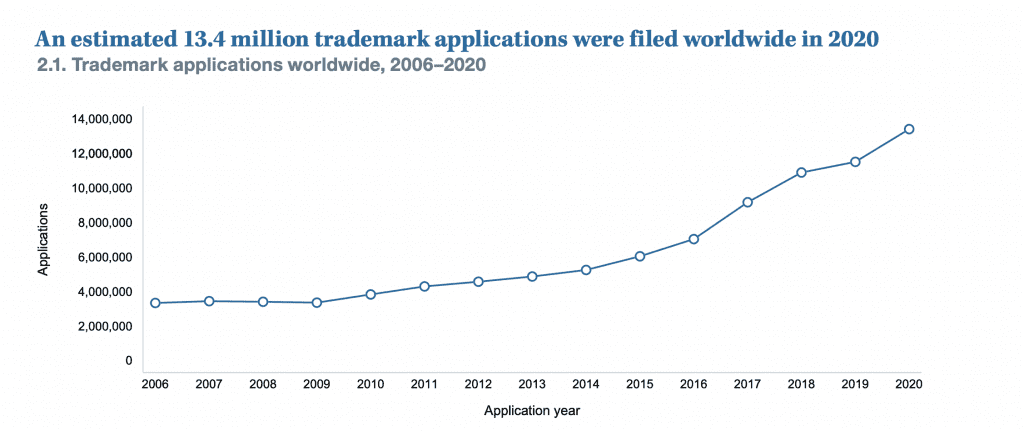Trademark filings were up in 2020, according to new data from the World Intellectual Property Office. The Geneva-based intellectual property body’s latest research shows that despite the onset and continued impact of the COVID-19 pandemic, companies have continued to offer up new goods and services, and seek out trademark registrations for the corresponding branding. Based on data supplied by 150 national and regional authorities, the WIPO revealed in its recently-released 2021 World Intellectual Property Indicators Report that an estimated 13.4 million trademark applications for registration covering a total of 17.2 million classes of goods/services were filed worldwide in 2020, up 16.5 percent from the number of applications filed during pre-pandemic 2019.
Marking what the WIPO says was the eleventh consecutive year of growth for trademark filings, the more than 15 percent rise in global trademark application filing activity in 2020 is particularly striking, according to UN agency, in light of the fact that “many countries around the global saw a considerable downturn in economic activity during the COVID-19 pandemic.” Yet, trademark filing activity grew “substantially” in 16 of the top 20 trademark offices throughout the year. In fact, the WIPO found that during 2020, 11 trademark offices recorded double-digit growth – ranging from 12.2 growth in Germany to a whopping 44.3 percent growth rate in Indonesia.
Growth in the number of filings amid the pandemic “shows how enterprises across the globe have brought new products and services to the market,” WIPO Director General Daren Tang said in connection with the report, noting that “enterprises are finding opportunities to reach customers in new ways, open up new markets, and bring their ideas to the world using intellectual property,” which comes in contrast to the financial crisis of 2008, for instance, when the WIPO found that growth in such filings “contracted sharply.”
As with other forms of intellectual property, the increase in total trademark filings worldwide is “primarily due to the sheer volume of trademark applications filed in China,” the WIPO found. For example, in 2020, the IP office of China, alone, accounted for 73.1 percent of the annual increase in global trademark filings (measured in application class counts), followed by increases in the U.S. (9.6 percent), Russia (4.4 percent), Iran (4.2 percent), and Turkey (3.9 percent).

China’s growth in application filings was driven primarily by domestic filings made by Chinese residents. At the same time, it is worth noting that applications from Chinese entities accounted for “by far the largest share of non-resident trademark filings in the U.S.” in 2020, with Chinese-filed applications representing 56.2 percent of all filings with the U.S. Patent and Trademark Office (“USPTO”) in 2020, up from 34 percent in 2019. For a point of context, “much smaller volumes” of applications were filed with the USPTO by entities from the United Kingdom (6 percent) and Canada (5.4 percent).
Meanwhile, U.S. filers were responsible for 20.9 percent of non-resident trademark applications lodged with the relevant office in India, 22.5 percent of non-resident applications filed in China, and 25.8 percent of non-resident trademark applications filed with the European Union Intellectual Property Office (“EUIPO”). Addressing what applicants consider when determining which countries to file in beyond their native base, the WIPO states that “the relative appeal of the various foreign markets for selling their goods and services, geographical proximity to these markets, and the existence of well-established historical ties between the trademark holder’s country and residence and the destination country” are among some of the key factors.
In terms of the individual classes of goods/services that were the subject of the most applications for non-resident applicants, the WIPO found that “clothing and accessories” was the second most frequently listed sector in applications filed in both Russia and the U.S., while goods in Class 9, which includes computer and software products and electrical and scientific products – and quite notably, face masks – was the most filed-for on a global basis, followed by Class 35, which covers services for advertising and business management.
Finally, the number of active trademark registrations was up in 2020, as well, totaling 64.4 million registrations in-force across nearly 150 global trademark offices, an increase of almost 12 percent compared to 2019. Maybe unsurprisingly, a whopping 30.2 million of those registrations were issued by the China IP office, followed by the USPTO (2.6 million), India’s trademark office (2.4 million), and Japan’s office (almost 2 million).
The overarching growth of trademark filings – and active trademarks – in 2020, echoes Novagraaf’s research around the pandemic’s impact on intellectual property filing strategies, with the international patent and trademark consultancy indicating that while a massive 88 percent of intellectual property professionals say that they “have felt the impact of the pandemic on their organizations,” the majority, nonetheless, said that they “anticipate a strong recovery.”
As the managing director of one unnamed luxury fashion brand stated during Novagraaf’s March 2021 IP roundtable, “When the pandemic started, our company reacted in two different ways. The first reaction was to protect ourselves and not to move. The second reaction was the complete opposite: We thought the pandemic was actually the time to protect ourselves more robustly [by filing new applications].” In other words, that director stated that one the company “secured all of the risks,” it then “looked deeply at the opportunities” for growth in its portfolio of rights and registrations.
Chances are, this may have included filing applications for face masks, which many brands rushed to create in the immediate wake of the pandemic, and any number of goods/services that fall within the realm of pandemic-accelerated trends/developments, such as repair/refurbishment services as the industry moves to adopt sustainability-focused initiatives, or e-commerce and digital-focused services. In the midst – as well as the wake – of the pandemic, no shortage of companies, including those in the luxury space, have embraced e-commerce and online shopping services with far more vigor than in the past, and have looked to trademark offices across the globe to lodge applications for such endeavors in the process.
Novagraaf views the WIPO’s latest findings as evidence of “the optimism that is being shared by many brands and business leaders around the world, especially those based in Asia,” and which is expected to carry on as fashion and luxury continues to rebound from the depths of pandemic sales lows in an increasingly competitive market.











